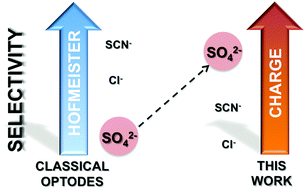Sulphate-selective optical microsensors: overcoming the hydration energy penalty†
Abstract
Novel membrane-free chemically modified polystyrene microspheres for the optical detection of sulphate in aqueous media are introduced. The working principle of this sensor is based on the surface mass-extraction equilibrium of the target species. This allows overcoming the strong hydration energy penalty, a typical problem for the detection of divalent anions. This optical sensor exhibits both enhanced sensitivity and selectivity, which allows the accurate detection of sulphate in biological samples. To illustrate these features the determination of sulphate in urine is presented.


 Please wait while we load your content...
Please wait while we load your content...